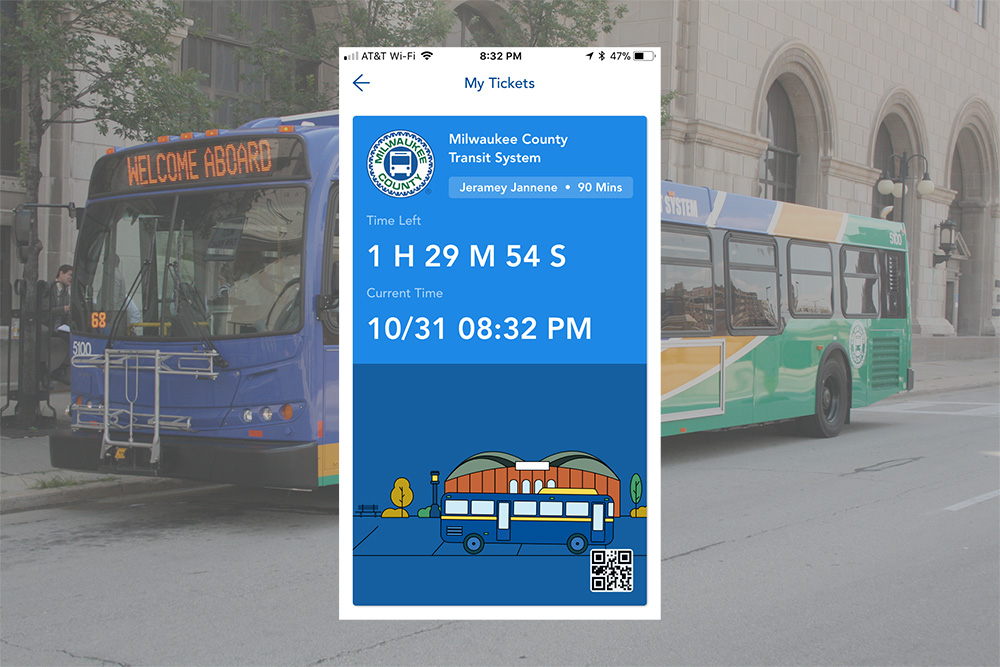Transit System’s Bus App Is a Hit
In just over one year, new app generated twice as much revenue as it cost to develop.
The Milwaukee County Transit System‘s launch of a smartphone application has made it easier than ever to ride a bus. and thousands of riders are taking notice. The application eliminates the need to purchase an M-Card, the system’s fare card system, or carry exact change. Riders can simply install the app, add a credit card or debit card to purchase tickets and hop aboard. Since its launch in November 2017, the Ride MCTS has been downloaded more than 52,000 times, with riders purchasing 191,000 tickets.
Riders can use the app to purchase electronic tickets ($2 each), find routes between locations and track bus arrival times based on real-time location data.
Usage really took off in April of this year, when an Android app was launched to pair with the original iPhone application. MCTS also ramped up marketing of the application at that point, running advertisements on a host of mediums, including the buses themselves.
Through the end of October, the 191,000 rides would have brought in $382,000 to MCTS, less credit card processing fees and any promotional discounts. “It’s really good to see that the revenue is nearly twice the cost of development, by the end of this month it will be more than double. Pretty good for something that’s just a year old,” MCTS marketing director Brendan Conway told Urban Milwaukee. MCTS leveraged a federal grant to support the development of the application, which cost $180,000.
The app was developed in partnership with Madison-based Tixora.
Riders using the app purchase their ticket before getting on the bus and then show their phone screen to the driver who visually validates the fare. The drivers are able to easily validate the fare by looking for a moving countdown clock and an animated graphic that includes a MCTS bus driving past Miller Park. The moving graphics help prevent fraud, with the day’s date also included on the display to ensure validity. For those seeking to learn how to use the app, MCTS has prepared a how-to guide.
Tickets include 90-minute transfers to ride additional lines, of which an additional 60,000 have been activated within the app.
Who Is Using the App?
Given that tickets are purchased independent of the route, and many MCTS lines intersect or overlap in high ridership areas, it’s difficult to discern exactly what routes the riders are using.
Using the number of requests for route-based, real-time information, the app appears to be most commonly used on the system’s Green Line (1,537,067 requests), Route 14 (1,102,856), Route 15 (972,405), Route 80 (869,601) and the Gold Line (814,9635).
Curiously absent from the Ride MCTS app list are routes 30 and 30x, the system’s second busiest line with 11,699 daily rides in 2016.
By contrast, the most popular route in the app, the Green Line, provided 6,267 daily rides in 2016 between Bayshore Mall and General Mitchell International Airport. The third-place route by app usage, Route 15, overlaps with the Green Line through Downtown and the north end of Bay View, indicating a likely high amount of app users riding between Downtown, Walker’s Point and Bay View.
According to its 2017 annual report, the system provided 34,604,044 rides last year. That number is down almost six million from 2016 (40,256,308) and over 10 million from 2011 (44,753,412). The revenue-strapped system has dealt with nearly two decades of fare increases and service reductions.
If you think stories like this are important, become a member of Urban Milwaukee and help support real independent journalism. Plus you get some cool added benefits, all detailed here.
Eyes on Milwaukee
-
Church, Cupid Partner On Affordable Housing
 Dec 4th, 2023 by Jeramey Jannene
Dec 4th, 2023 by Jeramey Jannene
-
Downtown Building Sells For Nearly Twice Its Assessed Value
 Nov 12th, 2023 by Jeramey Jannene
Nov 12th, 2023 by Jeramey Jannene
-
Immigration Office Moving To 310W Building
 Oct 25th, 2023 by Jeramey Jannene
Oct 25th, 2023 by Jeramey Jannene
Transportation
-
Congestion Pricing Cuts Air Pollution in New York City
 Dec 14th, 2025 by Jeff Wood
Dec 14th, 2025 by Jeff Wood
-
FTA Tells Milwaukee to Crack Down on Fare Evasion — Even Where Fares Don’t Exist
 Dec 12th, 2025 by Graham Kilmer
Dec 12th, 2025 by Graham Kilmer
-
Will GOGO’s Bus Service Ever Get Going?
 Dec 9th, 2025 by Jeramey Jannene
Dec 9th, 2025 by Jeramey Jannene






















